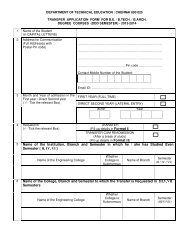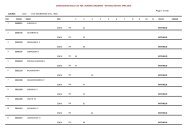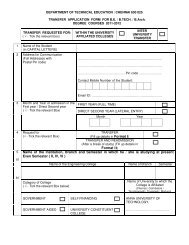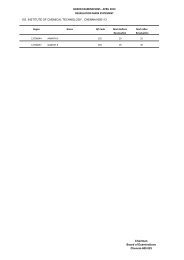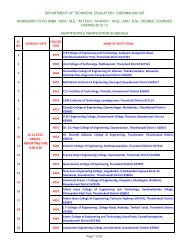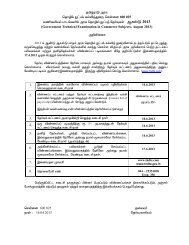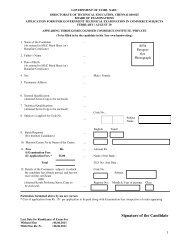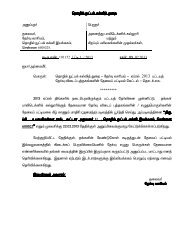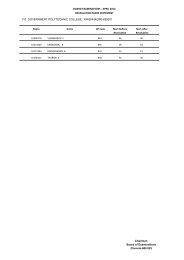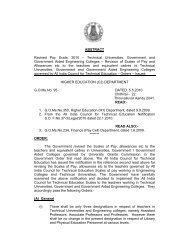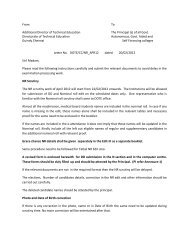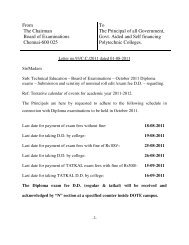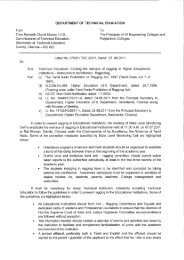SECOND ORDER DIFFERENTIAL EQUATIONS
SECOND ORDER DIFFERENTIAL EQUATIONS
SECOND ORDER DIFFERENTIAL EQUATIONS
Create successful ePaper yourself
Turn your PDF publications into a flip-book with our unique Google optimized e-Paper software.
UNIT - V<br />
<strong>SECOND</strong> <strong>ORDER</strong> <strong>DIFFERENTIAL</strong><br />
<strong>EQUATIONS</strong><br />
5.1. Solutionof secondorderdifferentialequationswithconstant 2<br />
d y dy<br />
coefficients in the form a + b + cy = 0.<br />
S imple P roblems<br />
2<br />
dx dx<br />
5.2 Solutionofsecondorderdifferentialequationsintheform 2<br />
d y dy<br />
a + b + cy = f(<br />
x)<br />
. Where a,b and c are constants and<br />
2<br />
dx dx<br />
f(x ) = e mx . Simple problems.<br />
5.3. Solutionofsecondorderdifferentialequationsintheform 2<br />
d y dy<br />
a + b + cy = f(<br />
x).<br />
W here a,b and c are constants a nd f(x ) =<br />
2<br />
dx dx<br />
sinmx or cosmx. Simple problems<br />
5.1 <strong>SECOND</strong> <strong>ORDER</strong> <strong>DIFFERENTIAL</strong> <strong>EQUATIONS</strong><br />
Introduction:<br />
In the last unit, we learnt first order differential equation. In this<br />
unit, we will learn second order differential equation.<br />
The second order differential equation is of the form<br />
2<br />
d y dy<br />
a + b + cy = f(<br />
x).<br />
(1)<br />
2<br />
dx dx<br />
W here a,b and c are real numbers and f(x ) is a function of x .<br />
W e use differential operators D y, D 2 y in (1), w e get<br />
2<br />
d<br />
( aD + bD + c)<br />
y = f(<br />
x)<br />
where D=<br />
dx<br />
Now, w e put f(x ) = 0 in (1), w e get<br />
2<br />
d y dy<br />
a + b + cy = 0<br />
(3)<br />
2<br />
dx dx<br />
297<br />
(2)
The solution of (3) is called complementary function (CF) of (1).<br />
T o solv e (3), we assume a trial solution y = e px for some value of<br />
2<br />
dy px d y 2 px<br />
p. Then = pe and = p e .<br />
dx<br />
2<br />
dx<br />
S ubstituting these v alues in (3), we get<br />
2<br />
px<br />
px<br />
ap e + bpe + ce<br />
px 2<br />
e [ ap + bp + c]<br />
= 0<br />
2<br />
ap + bp + c = 0<br />
px<br />
= 0<br />
T his equation in p is called the A ux illary E quation (A E )<br />
Solving (4), we get two roots say p1 and p2. Then the following<br />
three cases arise.<br />
Case (i)<br />
I f the roots p1 and p2 are real a nd distinct, then the solution of (3) is<br />
Case (ii)<br />
y = Ae +<br />
p1x p2x<br />
Be<br />
I f the roots p1 and p2 are real and equal, then the solution of (3) is<br />
Case (iii)<br />
p1 x<br />
y = e ( Ax + B)<br />
If the roots 1 pand 2 p arecomplexsayp1 = α + i β and p2 = α -iβ, then<br />
the solution of (3) is<br />
y<br />
x<br />
= α<br />
e<br />
[ A cos βx<br />
+ Bsinβx]<br />
I n a ll cases, A a nd B are arbitrary consta nts.<br />
298<br />
(4)
5.1 WORKED EXAMPLES<br />
PART – A<br />
1. If roots of the auxillary equation are<br />
of the differential equation?<br />
1<br />
± i<br />
2<br />
3<br />
, what is the solution<br />
2<br />
Solution:<br />
1<br />
H ere, the roots are complex and α = ,<br />
2<br />
.<br />
β =<br />
3<br />
,<br />
2<br />
. . The solution of differential equation is<br />
1<br />
x<br />
2<br />
y = e [ A cos<br />
3<br />
x + Bsin<br />
2<br />
3<br />
x]<br />
2<br />
2. Find the solution of (D 2 – 81) y = 0<br />
Solution:<br />
The auxillary equation is p 2 –81 = 0<br />
(p+9) (p-9) = 0<br />
p1 = -9, p2 = 9<br />
H ere, the roots are rea l a nd distinct<br />
. . . The solution of differential equation is<br />
y =Ae -9x +Be x 9<br />
2<br />
d y<br />
3. Solve + 64y<br />
= 0<br />
2<br />
dx<br />
Solution:<br />
2<br />
d y<br />
2<br />
Given + 64y<br />
= 0 ( D + 64)<br />
y = 0<br />
2<br />
dx<br />
The auxillary equation is p 2 +64=0<br />
p = ± 8i<br />
H ere, the roots are complex ,α=0 and β = 8<br />
. . . T he solution is y = A cos 8x + B sin 8x<br />
299
4. Solve (D 2 -2D-3)y=0<br />
Solution:<br />
The auxillary equation is p 2 -2p-3=0<br />
(p+1) (p-3) = 0<br />
p1 = -1, p2 = 3<br />
H ere, the roots are rea l a nd distinct<br />
. . . The solution is y = Ae -x + Be 3x<br />
5. Solve (D 2 -4D-1) y =0<br />
Solution:<br />
The auxillary equation is p 2 -4p-1 = 0<br />
H ere a = 1, b = -4, c = -1<br />
P =<br />
=<br />
=<br />
− b ±<br />
b<br />
2a<br />
2 −<br />
2(<br />
1)<br />
4ac<br />
4 ± 16 − 4(<br />
1)(<br />
−1)<br />
4 ± 20<br />
2<br />
4 ± 2 5<br />
= = 2 ± 5<br />
2<br />
So, p1 = 2 + 5andp2= 2 − 5<br />
H ere, the roots are rea l a nd distinct<br />
. . . The solution is<br />
y =Ae (2 + 5 )x + Be<br />
(2 - 5 )x<br />
300
2<br />
d y dy<br />
6. Solve − 6 + 9y<br />
= 0<br />
2<br />
dx dx<br />
Solution:<br />
2<br />
Given:<br />
d y dy<br />
− 6 + 9y<br />
= 0<br />
2<br />
dx dx<br />
<br />
2<br />
( D − 6D<br />
+ 9)<br />
y = 0<br />
The auxillary equation is p 2 –6p+9 = 0<br />
(p-3)(p-3)=0<br />
p1=3, p2 = 3<br />
Here, the roots are real and equal.<br />
.. The solution is y = e 3x [Ax+B]<br />
7. Solve (D 2 +D+2)y =0<br />
Solution:<br />
The auxillary equation is p 2 +p+2 = 0<br />
Here a = 1, b = 1, c = 2<br />
2<br />
− b ± b − 4ac<br />
P =<br />
2a<br />
−1±<br />
1−<br />
4(<br />
1)(<br />
2)<br />
=<br />
2(<br />
1)<br />
−1±<br />
− 7<br />
=<br />
2<br />
−1±<br />
i 7<br />
=<br />
2<br />
−1<br />
7<br />
= ± i<br />
2 2<br />
1<br />
H ere, the roots are complex , α = − , β =<br />
2<br />
−1<br />
. . 7 7<br />
. The solution is y = e [ A cos x Bsin<br />
x<br />
2 2<br />
x<br />
2<br />
+<br />
301<br />
7<br />
2
PART – B<br />
1. Solve (D 2 π<br />
+1) y = 0 when x = 0, y = 2 and x = , y=-2.<br />
2<br />
Solution:<br />
The auxillary equation is p 2 + 1 = 0<br />
p = ± i<br />
H ere, the roots are complex , β = 1<br />
. . . The solution is<br />
y =A cosx +B sinx … 1<br />
When x=0, y=2, the equation (1) becomes<br />
A cos0 + B sin0 = 2<br />
A + 0 = 2<br />
A = 2<br />
π<br />
When x = , y=-2, the equation (1) becomes<br />
2<br />
π π<br />
A cos +B sin = -2<br />
2 2<br />
0 + B = -2<br />
B = -2<br />
. . . The required solution is<br />
y = 2 cosx – 2 sinx<br />
2. Show that the solution of the equation (D 2 + 3D + 2) y = 0 if y(0)<br />
= 1 and y 1 (0) = 0 is y = 2e -x –e -2x<br />
Solution:<br />
The auxillary equation is p 2 +3p+2=0<br />
Here, the roots are real and distinct<br />
(p+1) (p+2) = 0<br />
p1 = -1, p2 = -2<br />
302
. . . The solution is y = Ae -x + Be -2x<br />
… 1<br />
Now, y′ = -A e -x –2Be -2x<br />
… 2<br />
If y(0) = 1, the equation (1) becomes<br />
A +B =1 … 3<br />
I f y’(0) =0 , the equation (2) becomes<br />
A+2B=0 … 4<br />
S olv ing (3) and (4) we get A =2, B=-1<br />
∴The required solution is<br />
y=2e -x -e -2x<br />
5.2. SOLUTION OF <strong>SECOND</strong> <strong>ORDER</strong> <strong>EQUATIONS</strong> IN THE FORM<br />
2<br />
d y dy<br />
a + b + cy = f(<br />
x)<br />
WHERE A,B AND C ARE CONSTANTS<br />
2<br />
dx dx<br />
mx<br />
AND f(x) = e .<br />
Introduction:<br />
In previous section, we find the complementary function . In this<br />
section, we have to find the particular integral (PI) and the general<br />
solution of a second order differentia l equation.<br />
The Solution of Differential equation with Constant Coefficients is<br />
y=CF+PI<br />
Method of finding particular integral<br />
Consider (aD 2 +bD+c)y = e mx where m is a constant.<br />
L et f(D ) = aD 2 +bD+c<br />
1<br />
T hen P I is giv en by<br />
f(<br />
D)<br />
Three cases arise in PI<br />
Case (i)<br />
If f(m) ≠<br />
0<br />
then PI<br />
=<br />
1<br />
f(<br />
D)<br />
e<br />
mx =<br />
e<br />
mx =<br />
303<br />
mx<br />
e<br />
f(<br />
m)<br />
mx<br />
e<br />
f(<br />
m)
Case (ii)<br />
Case (iii)<br />
If f(m) = 0<br />
If f(m) = 0<br />
and<br />
f '(m)<br />
and f '(m)<br />
≠ 0then<br />
= 0<br />
and<br />
304<br />
PI =<br />
f ''(m)<br />
mx<br />
x e<br />
f'(<br />
m)<br />
≠ 0 then<br />
5.2 WORKED EXAMPLE<br />
PART – A<br />
PI =<br />
2<br />
mx<br />
x e<br />
f"<br />
( m)<br />
1. Find the complementary function of (D 2 +16)y= e x<br />
Solution:<br />
The auxiliary equation is p 2 +16=0 p=±4i<br />
Here, the roots are complex , β=4<br />
∴C F = A cos 4x + B sin 4x<br />
2. F ind the complementary function of (D 2 -60D+800)y=e 40x<br />
Solution:<br />
The auxiliary equation is p 2 -60p+800=0<br />
(p-40) (P-20) =0<br />
P1=40, P 2=20<br />
H ere the roots are rea l a nd distinct<br />
∴CF = Ae 40x + Be 20x<br />
3. F ind the particular integra l of (D 2 +1) y =1<br />
Solution:<br />
1 1<br />
PI =<br />
= e<br />
2 2<br />
D + 1 D + 1<br />
1 1<br />
= = = 1<br />
0 + 1 1<br />
0
4. F ind the particular integra l of (D 2 +7D+14) = 8e -x<br />
Solution:<br />
1<br />
−x<br />
PI =<br />
8e<br />
2<br />
D + 7D<br />
+ 14<br />
−x<br />
8e<br />
=<br />
2<br />
( −1)<br />
+ 7(<br />
−1)<br />
+ 14<br />
=<br />
−x<br />
8e<br />
8<br />
−x<br />
= e<br />
5. F ind the particular integra l of (D 2 -2D-3)y = e -x<br />
Solution:<br />
1 −x<br />
PI =<br />
e<br />
2<br />
D − 2D<br />
− 3<br />
−x<br />
x e<br />
=<br />
2D<br />
− 2<br />
Since f(<br />
−1)<br />
= 0<br />
−x<br />
x e<br />
=<br />
2(<br />
−1)<br />
− 2<br />
−x<br />
x e<br />
= −<br />
4<br />
PART - B<br />
1. Solve (D 2 +5D+6)y=30<br />
Solution:<br />
The auxiliary equation is p 2 +5p+6=0<br />
(p+2) (P+3) =0<br />
P1=-2, P 2=-3<br />
Here, the roots are real and distinct<br />
∴CF = Ae -2x +Be -3x<br />
1<br />
Now PI =<br />
30<br />
2<br />
D + 5D<br />
+ 6<br />
30e°<br />
=<br />
2<br />
D + 5D<br />
+ 6<br />
30e°<br />
=<br />
2<br />
0 + 5(<br />
0)<br />
+ 6<br />
30<br />
=<br />
6<br />
PI = 5<br />
∴ T he R equired solution is<br />
Y=CF+PI =Ae -2x +Be -3x +5<br />
305
2. Solve (D 2 +6D +5) y =2e x<br />
Solution:<br />
The auxiliary equation is p 2 +6p+5=0<br />
(p+1) (P+5) =0<br />
P1=-1, P 2=-5<br />
H ere the roots are rea l a nd distinct<br />
∴CF = Ae -x +Be -5x<br />
1<br />
x<br />
Now PI =<br />
2e<br />
2<br />
D + 6D<br />
+ 5<br />
x<br />
2e<br />
=<br />
2<br />
1 + 6(<br />
1)<br />
+ 5<br />
x<br />
2e<br />
=<br />
12<br />
x<br />
e<br />
PI =<br />
6<br />
∴The required solution is<br />
Y=CF+PI<br />
x<br />
-x<br />
-5x<br />
e<br />
Ae + Be +<br />
6<br />
3. Solve<br />
x<br />
2<br />
(D + D)<br />
y = e 2<br />
Solution:<br />
The auxiliary equation is p 2 +p=0<br />
p (p+1)=0<br />
P1=0, P 2=-1<br />
H ere the roots are rea l a nd distinct<br />
∴CF = Ae 0 +Be -x =A +Be -x<br />
x<br />
2<br />
1<br />
Now PI =<br />
e<br />
2<br />
D + D<br />
306
x<br />
2<br />
e<br />
=<br />
2<br />
1 <br />
+<br />
2 <br />
e<br />
=<br />
x<br />
2<br />
3<br />
4<br />
x<br />
2<br />
1<br />
2<br />
4<br />
PI = e<br />
3<br />
∴The required solution is<br />
y=CF+PI<br />
-x<br />
3<br />
= A + Be + e<br />
4<br />
2<br />
4x<br />
4. Solve (D − D − 12)<br />
y = e<br />
Solution:<br />
The auxiliary equation is p 2 -p-12=0<br />
(p-4) (p+3)=0<br />
p1=4, p2=-3<br />
H ere the roots are rea l a nd distinct<br />
∴CF = Ae 4x +Be -3x<br />
1 4x<br />
Now PI =<br />
e<br />
2<br />
D − D − 12<br />
4x<br />
x e<br />
=<br />
2D<br />
− 1<br />
4x<br />
x e<br />
=<br />
2(<br />
4)<br />
−1<br />
4x<br />
x<br />
2<br />
x e<br />
PI =<br />
7<br />
∴ T he required solution is<br />
y=CF + PI<br />
= Ae<br />
4x<br />
+ Be<br />
-3x<br />
x e<br />
+<br />
7<br />
4x<br />
Since f(<br />
4)<br />
307<br />
= 0
5. Solve (D 2 -2D+1) y =e x<br />
Solution:<br />
6<br />
The auxiliary equation is p 2 -2p+1=0<br />
(p-1) (p-1) =0<br />
p1=1, p 2=1<br />
H ere the roots are rea l a nd equa l<br />
∴C F = e x (A x +B)<br />
Now PI<br />
=<br />
D<br />
2<br />
2<br />
x<br />
PI =<br />
2<br />
1<br />
e<br />
− 2D<br />
+ 1<br />
∴The required solution is<br />
Y=CF+PI<br />
Solution:<br />
e<br />
x x<br />
= e +<br />
2<br />
x<br />
( Ax + B)<br />
e<br />
2<br />
x<br />
2<br />
x<br />
Since<br />
308<br />
f ( 1)<br />
d y dy<br />
−2x<br />
Solve −13<br />
+ 12y<br />
= 2e<br />
+ 5e<br />
2<br />
dx dx<br />
Given<br />
2<br />
2<br />
d y dy<br />
−13<br />
+ 12y<br />
= 2e<br />
2<br />
dx dx<br />
−2x<br />
−2x<br />
( D −13D<br />
+ 12)<br />
y = 2e<br />
+ 5e<br />
x<br />
+ 5e<br />
T he aux ilary equa tion is p 2 -13p+12=0<br />
x<br />
=<br />
x<br />
0,<br />
f'(<br />
1)<br />
(p-1) (p-12) =0<br />
p1=1, p2=12<br />
H ere the roots are rea l a nd distinct<br />
∴CF = Ae x +Be 12x<br />
= 0
1<br />
−2x<br />
Now PI1<br />
=<br />
2e<br />
2<br />
D − 13D<br />
+ 12<br />
−2x<br />
2e<br />
=<br />
2<br />
( −2)<br />
− 13(<br />
−2)<br />
+ 12<br />
−2x<br />
2e<br />
=<br />
4 + 26 + 12<br />
−2x<br />
e<br />
=<br />
21<br />
1<br />
x<br />
Now PI2<br />
=<br />
5e<br />
2<br />
D − 13D<br />
+ 12<br />
x<br />
5xe<br />
=<br />
Sincef(<br />
1)<br />
= 0<br />
2D<br />
− 13<br />
x<br />
5xe<br />
=<br />
2(<br />
1)<br />
− 13<br />
x<br />
5xe<br />
= −<br />
11<br />
∴ T he required solution is<br />
Y =CF+PI1+PI2<br />
−2x<br />
x<br />
x 12x e 5xe<br />
= Ae + Be + −<br />
21 11<br />
5.3 SOLUTION OF <strong>SECOND</strong> <strong>ORDER</strong> <strong>DIFFERENTIAL</strong><strong>EQUATIONS</strong><br />
2<br />
d y dy<br />
IN THE FORM a −b + cy = f(<br />
x)<br />
WHERE a,b AND c ARE<br />
2<br />
dx dx<br />
CONSTANTS AND f(x) = sin mx or cos mx where m is a<br />
constant ≠ 0<br />
INTRODUCTION<br />
In this section, we have to find the particular integral when f(x)<br />
=sin mx or cos m x where m is a constant<br />
Methods of finding PI<br />
C onsider f(x ) =sin m x<br />
309
Case (i)<br />
Express f(D) as function of D 2 ,say φ (D 2 ) and then replace D 2 with –m 2<br />
If φ(-m 2 )≠0,then<br />
PI =<br />
1<br />
sin mx<br />
f(<br />
D)<br />
1<br />
= sin mx<br />
2<br />
φ(<br />
D )<br />
1<br />
PI = sin mx<br />
2<br />
φ(<br />
−m<br />
)<br />
Case (ii)<br />
Sometimes we cannot form φ (D 2 ) Then we shall try to get<br />
φ(D,D 2 ) that is a function of D and D 2 . In such cases we proceed as<br />
follows.<br />
For Example<br />
1<br />
Now PI =<br />
sin2x<br />
2<br />
D + 2D<br />
+ 3<br />
1 2 2<br />
=<br />
sin2x<br />
Replace<br />
D by − 2<br />
2<br />
− 2 + 2D<br />
+ 3<br />
1<br />
= Sin 2x<br />
2D<br />
−1<br />
2D<br />
+ 1<br />
= sin2x<br />
multiply anddivide<br />
by 2D<br />
+ 1<br />
2<br />
4D<br />
−1<br />
2D(sin<br />
2x)<br />
+ sin2x<br />
=<br />
2<br />
4(<br />
−2<br />
) −1<br />
4cos<br />
2x<br />
+ sin2x<br />
=<br />
−17<br />
1<br />
= [ 4cos<br />
2x<br />
+ sin2x]<br />
−17<br />
Now consider f(x) = cos m x<br />
1<br />
Case (i): PI = cos mx<br />
2<br />
φ(-m<br />
)<br />
Case(ii): S ame as sin m x method<br />
General Solution:<br />
The general solution is y= CF+PI<br />
310
5.3 WORKED EXAMPLE<br />
PART - A<br />
1. Find the complementary function of (D 2 +49) y= cos 4x<br />
Solution:<br />
The auxiliary equation is p 2 +49=0<br />
p=±7i<br />
Here, the roots are complex ,β =7<br />
∴ C F = A cos 7x +B sin 7x<br />
2. Find the particular integral of (D 2 +14) y = sin 3x<br />
Solution:<br />
1<br />
PI = sin 3x<br />
2<br />
D + 14<br />
1<br />
= sin 3x<br />
2<br />
− 3 + 14<br />
sin 3x<br />
=<br />
5<br />
3. F ind the particular integra l of (D 2 +a 2 ) y = Cos b x<br />
Solution:<br />
1<br />
PI =<br />
2 2<br />
D + a<br />
cos bx<br />
1<br />
=<br />
2 2<br />
− b + a<br />
cos bx<br />
=<br />
2 2<br />
a − b<br />
cos bx<br />
1.) Solve ( − 4)<br />
y = sin2x<br />
Solution:<br />
D 2<br />
PART - B<br />
The auxiliary equation is − 4 = 0<br />
<br />
p<br />
2<br />
p 2<br />
= 4<br />
p = + 2<br />
p = 2,<br />
p = −2<br />
1<br />
2<br />
311
Here, the roots are real and distinct<br />
∴ CF = Ae<br />
2x<br />
+ Be<br />
−2x<br />
Now PI = ( sin2x<br />
)<br />
D<br />
1<br />
2 −<br />
4<br />
1<br />
= sin2x<br />
2<br />
− 2 − 4<br />
sin2x<br />
= −<br />
8<br />
∴ T he R equired solution is<br />
y = CF + PI<br />
= Ae<br />
2x<br />
+ Be<br />
−2x<br />
sin2X<br />
−<br />
8<br />
2.) Solve y = −16sin4x<br />
Solution:<br />
D 2<br />
The auxiliary equation is p 0<br />
2 =<br />
p, 0,<br />
p2<br />
0 = = <br />
Here, the roots are real and equal<br />
∴ CF = e<br />
0<br />
( Ax + B)<br />
= Ax + B<br />
1<br />
Now PI 16 sin4x<br />
2<br />
D<br />
− =<br />
1<br />
16 sin4x<br />
2<br />
4<br />
− =<br />
−<br />
PI= Sin4x<br />
∴ T he R equired solution is<br />
y =<br />
CF + PI<br />
= Ax + B + Sin4x<br />
312
2<br />
d y<br />
2<br />
3.) Solve + 16y<br />
= cos x<br />
2<br />
dx<br />
Solution:<br />
2<br />
d y<br />
2<br />
Given + 16y<br />
= cos x<br />
2<br />
dx<br />
2<br />
2<br />
( D + 16)<br />
y = cos x<br />
2 1 cos 2x<br />
( D + 16)<br />
y = +<br />
2 2<br />
1 0 1<br />
= e + cos 2x<br />
2 2<br />
The auxiliary equation is p 16 0<br />
2<br />
+ =<br />
p = + 4i<br />
Here, the roots are complex, β = 4<br />
∴CF<br />
= A cos 4x<br />
+ BSin4x<br />
1 0<br />
e<br />
PI 2<br />
1 =<br />
2<br />
D + 16<br />
0<br />
1 e<br />
=<br />
2 0 + 16<br />
1<br />
=<br />
32<br />
1 cos 2x<br />
PI 2 = .<br />
2 2 D + 16<br />
1 cos 2x<br />
= .<br />
2 2 − 2 + 16<br />
cos 2x<br />
=<br />
24<br />
∴ T he R equired solution is<br />
y =<br />
CF + PI<br />
1 cos 2x<br />
= A cos 4x<br />
+ BSin4x<br />
+ +<br />
32 24<br />
313
4.) Solve ( + 3D<br />
+ 2)<br />
y = sin2x<br />
D 2<br />
Solution:<br />
The auxiliary equation is p 3p<br />
2 0<br />
2<br />
+ + =<br />
( p + 2)(<br />
p + 1)<br />
= 0<br />
p1<br />
= −2,<br />
p2<br />
= −1<br />
Here, the roots are real and distinct<br />
−2x<br />
−x<br />
∴CF<br />
= Ae + Be<br />
1<br />
Now, PI =<br />
. Sin2x<br />
2<br />
D + 3D<br />
+ 2<br />
1<br />
=<br />
. Sin2x<br />
2<br />
− 2 + 3D<br />
+ 2<br />
1<br />
= . Sin2x<br />
3D<br />
− 2<br />
3D<br />
=<br />
9D<br />
2<br />
+ 2<br />
. Sin2x<br />
− 4<br />
3D<br />
+ 2<br />
= . Sin2x<br />
− 36 − 4<br />
3D(<br />
sin2x<br />
) + 2sin2x<br />
=<br />
− 40<br />
6cos<br />
2x<br />
+ 2sin2x<br />
=<br />
− 40<br />
−1<br />
=<br />
20<br />
[ 3cos<br />
2x<br />
+ sin2x]<br />
∴ T he R equired solution is<br />
y = CF + PI<br />
= Ae<br />
−2x<br />
+ Be<br />
−x<br />
1<br />
−<br />
20<br />
[ 3cos<br />
2x<br />
+ sin2x]<br />
314
5.) Solve ( − 2D<br />
− 8)<br />
y = 4cos<br />
3x<br />
Solution:<br />
D 2<br />
Solution: The auxiliary equation is − 2p<br />
− 8 = 0<br />
Here, the roots are real and distinct<br />
4x<br />
−2x<br />
∴CF<br />
= Ae + Be<br />
1<br />
Now, PI =<br />
4cos<br />
3x<br />
2<br />
D − 2D<br />
− 8<br />
1<br />
=<br />
4cos<br />
3x<br />
2<br />
− 3 − 2D<br />
− 8<br />
1<br />
= 4cos<br />
3x<br />
− 2D<br />
−17<br />
1 <br />
= −4<br />
4cos<br />
3x<br />
2D<br />
+ 17 <br />
2D<br />
−17<br />
<br />
= −4<br />
cos 3x<br />
2<br />
<br />
4D<br />
− 289 <br />
2D<br />
= −4<br />
<br />
( cos 3x)<br />
315<br />
p 2<br />
<br />
p<br />
−17cos<br />
3x<br />
<br />
− 325<br />
<br />
<br />
− 6sin3x<br />
−17cos<br />
3x<br />
<br />
= −4<br />
325<br />
<br />
−<br />
<br />
− 4<br />
= [ 6sin3x<br />
+ 17cos<br />
3x]<br />
325<br />
∴ T he R equired solution is<br />
y = CF + PI<br />
= Ae<br />
4x<br />
+ Be<br />
−2x<br />
4<br />
−<br />
325<br />
( p − 4)(<br />
p + 2)<br />
1<br />
=<br />
[ 6sin3x + 17cos3x ]<br />
4,<br />
p<br />
2<br />
= 0<br />
= −2
EXERCISE<br />
PART - A<br />
1.) If roots of the aux ilary equation are 2,7 what is the solution of the<br />
differential equation?<br />
2.) If roots of the aux ilary equation are 0,1 what is the solution of the<br />
differential equation?<br />
3.) If roots of the auxilary equation are -2,± i, what is the solution of<br />
the differential equation?<br />
4.) Find the solution of ( − 1)<br />
y = 0<br />
D 2<br />
d y<br />
5.) Find the solution of − 16y<br />
= 0<br />
2<br />
dx<br />
6.) Solve ( + 9)<br />
y = 0<br />
D 2<br />
7.) Find the solution of ( + 100)<br />
y = 0<br />
2<br />
D 2<br />
8.) Solve ( + 4D<br />
− 1020)<br />
y = 0<br />
D 2<br />
9.) Solve ( D − 5D<br />
+ 2)<br />
y = 0<br />
3 2<br />
10.) Solve ( D − 7D<br />
− 6)<br />
y = 0<br />
3 2<br />
d y dy<br />
11.) Solve + = 0<br />
2<br />
dx dx<br />
2<br />
12.) Solve ( − D −1)<br />
y = 0<br />
D 2<br />
13.) Solve ( + 4D<br />
+ 4)<br />
y = 0<br />
D 2<br />
2<br />
d y dy<br />
14.) Solve − 12 + 36y<br />
= 0<br />
2<br />
dx dx<br />
15.) Solve ( + D + 1)<br />
y = 0<br />
D 2<br />
16.) Solve ( D − D + 1)<br />
y = 0<br />
3 2<br />
2<br />
x<br />
17.) Find the Complementary function of ( D +<br />
13D<br />
− 90)<br />
y = e<br />
316
2<br />
x<br />
18.) Find the Particular integral of ( D − 3D<br />
+ 2)<br />
y = e<br />
2<br />
2x<br />
19.) Find the Particular integral of ( D + D + 4)<br />
y = 10e<br />
2<br />
3x<br />
20.) Find the Particular integral of ( D − 8D<br />
+ 15)<br />
y = e<br />
2<br />
5x<br />
21.) Find the Particular integral of ( D + 10D<br />
+ 25)<br />
y = e<br />
22.) Find the Complementary integral of ( + 25)<br />
y = cos ax<br />
23.) Find the Particular integral of ( + 25)<br />
y = Sinx<br />
24.) Find the Particular integral of ( + 10)<br />
y = sin3x<br />
d y<br />
25.) Find the Particular integral of − 4y<br />
= cos 4x<br />
2<br />
dx<br />
D 2<br />
D 2<br />
2<br />
PART - B<br />
1.) Solve ( 36)<br />
y = 0 when y(<br />
0)<br />
= 2<br />
D 2<br />
2<br />
317<br />
D 2<br />
+ and ( 0)<br />
= 12<br />
d y<br />
dy<br />
2.) Solve + y = 0 giv en that = 2and<br />
y=1 when x=0<br />
2<br />
dx<br />
dx<br />
3.) Solve ( 2D<br />
− 15)<br />
y = 0<br />
x=0<br />
D 2<br />
4.) Solve ( D − 20)<br />
y = 0<br />
D 2<br />
5.) Solve ( + 7D<br />
+ 12)<br />
y = 3<br />
D 2<br />
dy d y<br />
− given that = 0 and = 2 when<br />
2<br />
dx dx<br />
dy<br />
− giv en that y=5 and = −2<br />
when x =0<br />
dx<br />
2<br />
x<br />
6.) Solve ( )<br />
D + 3D<br />
+ 2 y = 2e<br />
2<br />
x<br />
7.) Solve ( D + 12D<br />
+ 36)<br />
y = e<br />
2<br />
8.) Solve ( ) 2<br />
D + D + 4 y = e<br />
2<br />
2x<br />
9.) Solve ( D − 3D<br />
+ 2)<br />
y = e<br />
2<br />
4x<br />
10.) Solve ( )<br />
D +<br />
6D<br />
+ 8 y = e<br />
x<br />
−<br />
y 1<br />
−<br />
−<br />
2
11.) Solve<br />
2<br />
d y<br />
−<br />
2<br />
dx<br />
dy<br />
4 + 4y<br />
= e<br />
dx<br />
2x<br />
2<br />
2 ax<br />
12.) Solve ( )<br />
D<br />
+ 2aD<br />
+ a<br />
y = e<br />
2<br />
7x<br />
13.) Solve ( )<br />
D<br />
+ 14D<br />
+ 49 y = 4e<br />
2<br />
x<br />
14.) Solve ( D − 2D<br />
+ 4)<br />
y = 5 + 3e<br />
15.) Solve<br />
2<br />
d y<br />
+<br />
2<br />
dx<br />
−<br />
dy<br />
8 + 15y<br />
= e<br />
dx<br />
−<br />
−<br />
−3x<br />
+ e<br />
2<br />
5x<br />
5x<br />
16.) Solve ( D + 10D<br />
+ 25)<br />
y = e + e<br />
17.) Solve ( + 16)<br />
y = sin9x<br />
D 2<br />
18.) Solve ( − 25)<br />
y = sin5x<br />
D 2<br />
19.) Solve ( + 100)<br />
y = cos 2x<br />
D 2<br />
2<br />
d y<br />
20.) Solve − 2y<br />
= cos 3x<br />
2<br />
dx<br />
21.) Solve ( + 2D<br />
− 3)<br />
y = sinx<br />
D 2<br />
22.) Solve ( + D − 2)<br />
y = Sin3x<br />
D 2<br />
23.) Solve ( + 4D<br />
+ 13)<br />
y = 4cos<br />
3x<br />
D 2<br />
24.) Solve ( − 8D<br />
+ 9)<br />
y = 8cos<br />
5x<br />
D 2<br />
25.) Solve ( − 2D<br />
− 8)<br />
y = 4cos<br />
2x<br />
1.)<br />
D 2<br />
2x<br />
7x<br />
318<br />
−<br />
3x<br />
ANSWERS<br />
PART - A<br />
y = Ae + Be<br />
2.)<br />
2x<br />
3.) y = e [ A cos x + Bsinx]<br />
−<br />
5.)<br />
4x<br />
−4x<br />
4.)<br />
y = A + Be<br />
y = Ae<br />
x<br />
x −x<br />
+ Be<br />
y = Ae + Be<br />
6.) y = A cos 3x<br />
+ B sin3x<br />
7.) y = A cos10x<br />
+ B sin10x<br />
8.) y =<br />
Ae<br />
30x<br />
+ Be<br />
−34x
9.)<br />
11.)<br />
2 x<br />
x<br />
Be 3<br />
y = Ae +<br />
10.) y = Ae<br />
−x<br />
y = A + Be<br />
12.) y = Ae<br />
2x<br />
13.) y = e ( Ax + B)<br />
−<br />
15.)<br />
16.)<br />
17.)<br />
y<br />
= −x<br />
2<br />
e<br />
<br />
A cos<br />
<br />
<br />
3<br />
x + Bsin<br />
2<br />
3 <br />
x <br />
2 <br />
<br />
x <br />
<br />
<br />
11 11<br />
y = e 6 A cos x + Bsin<br />
x <br />
<br />
<br />
6<br />
6 <br />
5x<br />
−18x<br />
CF = Ae + Be<br />
18.)<br />
6<br />
xe x 3<br />
319<br />
3x<br />
+ Be<br />
1 5 <br />
<br />
+<br />
x<br />
2 <br />
<br />
−2<br />
x<br />
3<br />
+ Be<br />
6x<br />
14.) y = e ( Ax + B)<br />
e x −<br />
20.) −<br />
2<br />
21.)<br />
x −5x<br />
e<br />
2<br />
22.) CF=Acos5x+Bsin5x 23.)<br />
sinx<br />
24<br />
24.) Sin3x<br />
Cos4x<br />
25.) −<br />
20<br />
Part-B<br />
2<br />
19.)<br />
1.) y = 2cos<br />
6x<br />
+ 2sin6x<br />
2.) y = cos x + 2sin<br />
x<br />
3.)<br />
5.)<br />
1 5x<br />
1 −3x<br />
y = e + e<br />
4.) y = 2e<br />
20 2<br />
y = Ae<br />
y<br />
e<br />
−4x<br />
6x<br />
= −<br />
+ Be<br />
−3x<br />
7.) ( ) 49<br />
8.)<br />
+<br />
e<br />
Ax + B +<br />
1<br />
4<br />
x<br />
6.)<br />
x <br />
2 15 15 <br />
y = e A<br />
cos x + Bsin<br />
x<br />
+<br />
<br />
2<br />
2 <br />
−<br />
x<br />
2x<br />
y =<br />
Ae + Be + xe<br />
2x<br />
y = Ae<br />
4<br />
19<br />
e<br />
x<br />
2<br />
5x<br />
−x<br />
9.)<br />
+ 3e<br />
+ Be<br />
−4x<br />
−2x<br />
1 5 <br />
<br />
−<br />
x<br />
2 <br />
<br />
2x<br />
e<br />
x<br />
e<br />
+<br />
3
−4x<br />
10.)<br />
−4x<br />
−2x<br />
xe<br />
y = Ae + Be −<br />
2<br />
11.)<br />
2<br />
2x<br />
x 2x<br />
y = e ( Ax + B)<br />
+ e<br />
2<br />
12.)<br />
2<br />
−ax<br />
x −ax<br />
y = e ( Ax + B)<br />
+ e<br />
2<br />
13.)<br />
−7x<br />
2 −7x<br />
y = e ( Ax + B)<br />
+ 2x<br />
e<br />
14.)<br />
x<br />
y = e ( A cos 3x<br />
+ Bsin<br />
5 3 −x<br />
3x)<br />
+ + e<br />
4 7<br />
15.)<br />
−3x<br />
3x<br />
−3x<br />
−5x<br />
xe e<br />
y = Ae + Be + +<br />
2 48<br />
16.)<br />
5x<br />
2 −5x<br />
−5x<br />
e x e<br />
y = e ( Ax + B)<br />
+ +<br />
100 2<br />
17.)<br />
sin9x<br />
y = A cos 4x<br />
+ B sin 4x<br />
−<br />
65<br />
18.)<br />
5x<br />
−5x<br />
sin5x<br />
y = Ae + Be −<br />
50<br />
19.)<br />
cos 2x<br />
y = A cos10x<br />
+ Bsin10x<br />
+<br />
96<br />
20.) y = Ae<br />
2x<br />
−<br />
+ Be<br />
2x<br />
cos 3x<br />
−<br />
11<br />
21.)<br />
−3x<br />
x 1<br />
y = Ae + Be − ( cos x + 2sinx<br />
)<br />
10<br />
1<br />
130<br />
x −2x<br />
22.) y = Ae + Be − ( 3cos<br />
3x<br />
+ 11sin3x<br />
)<br />
2x<br />
= −<br />
1<br />
10<br />
23.) y e ( A cos 3x<br />
+ Bsin3x<br />
) + 3sin3x<br />
+ cos 3x<br />
1<br />
29<br />
24.) ( 4+<br />
7 ) x ( 4−<br />
7 ) x<br />
y = Ae + Be − ( 5sin5x<br />
+ 2cos<br />
5x)<br />
1<br />
10<br />
4x<br />
−2x<br />
25.) y = Ae + Be − ( sin2x<br />
+ 3cos<br />
2x)<br />
320




